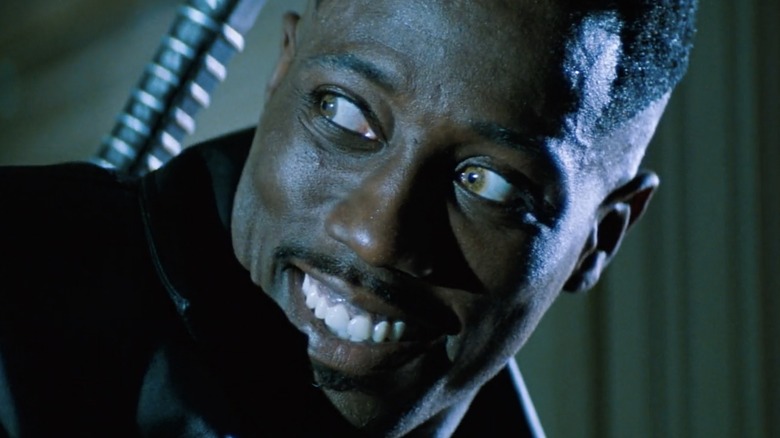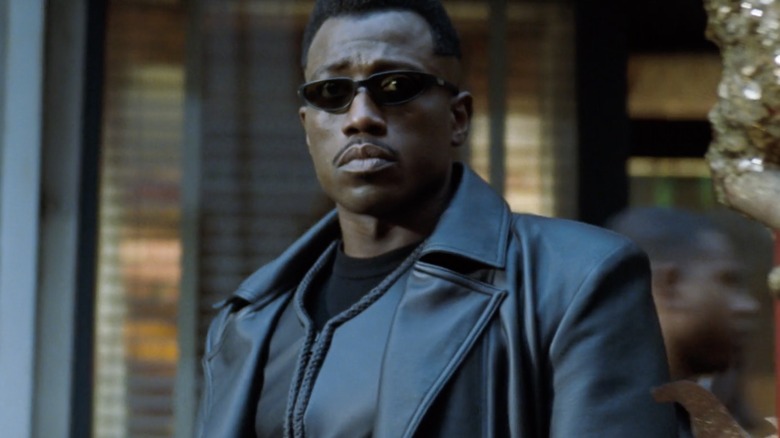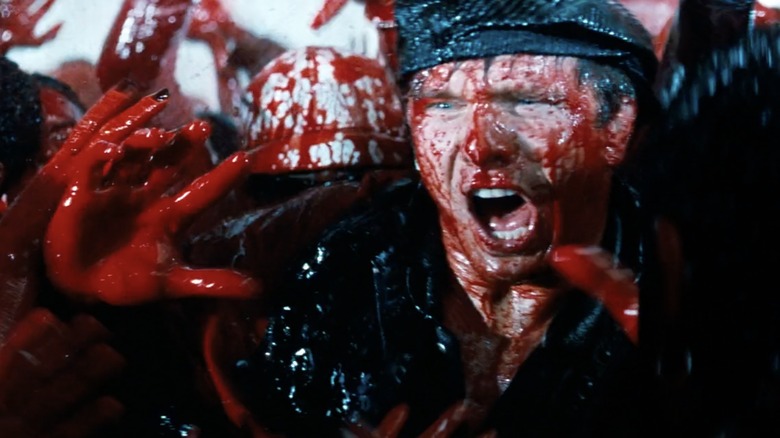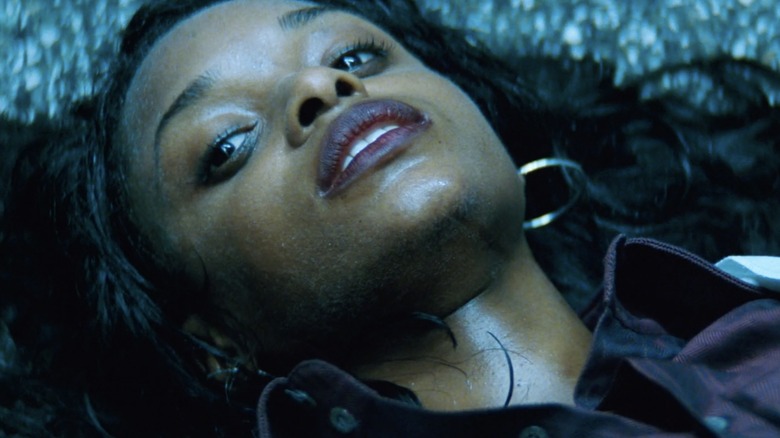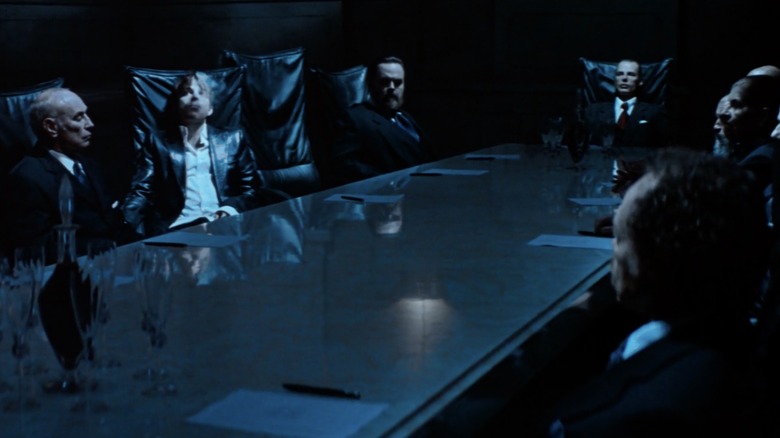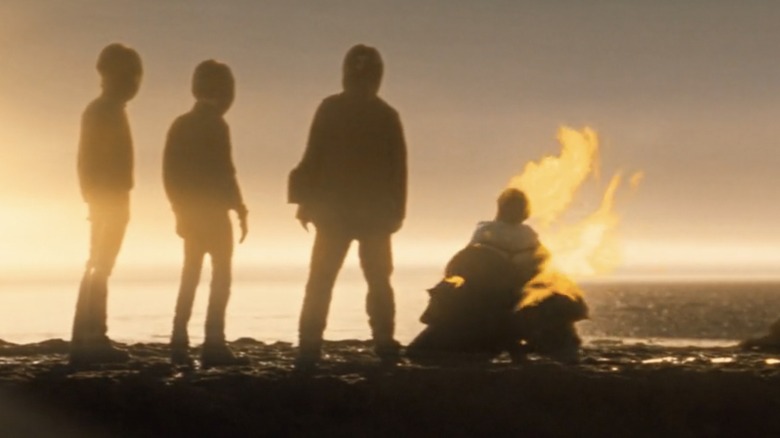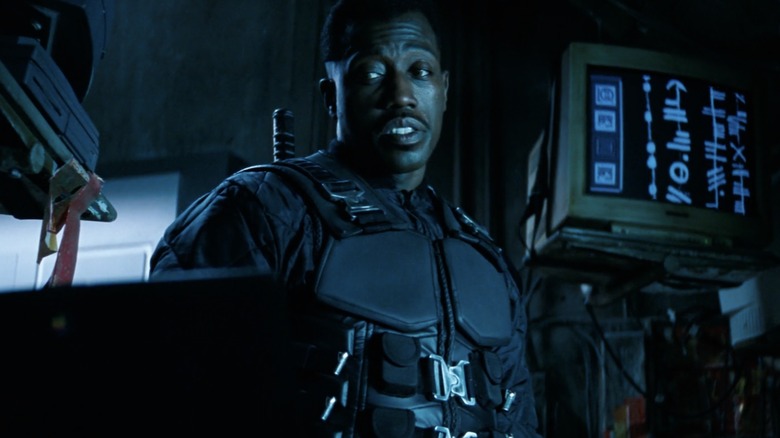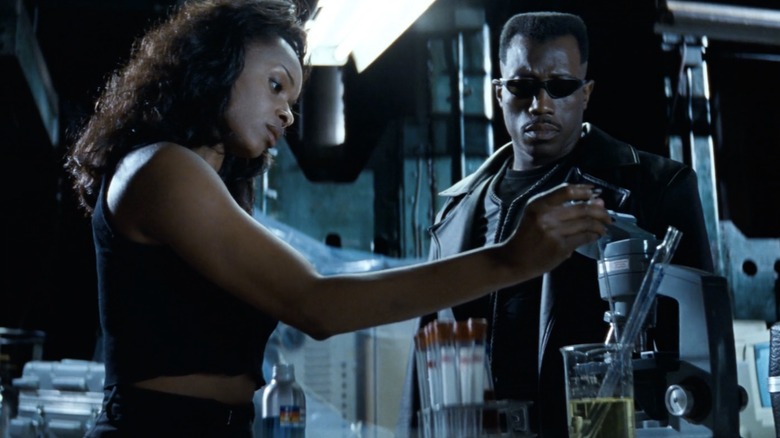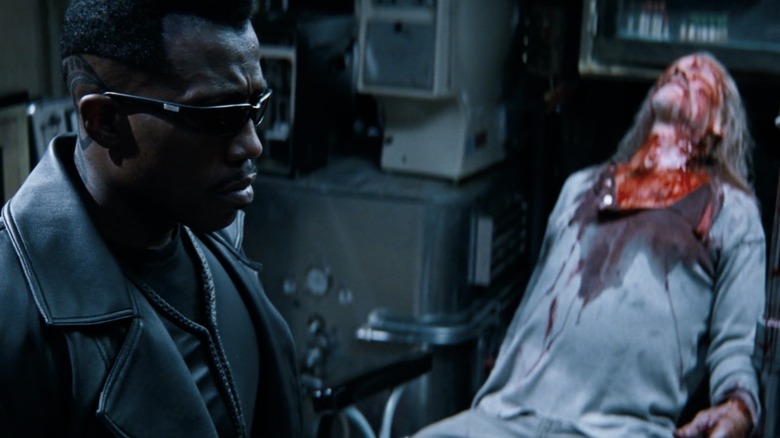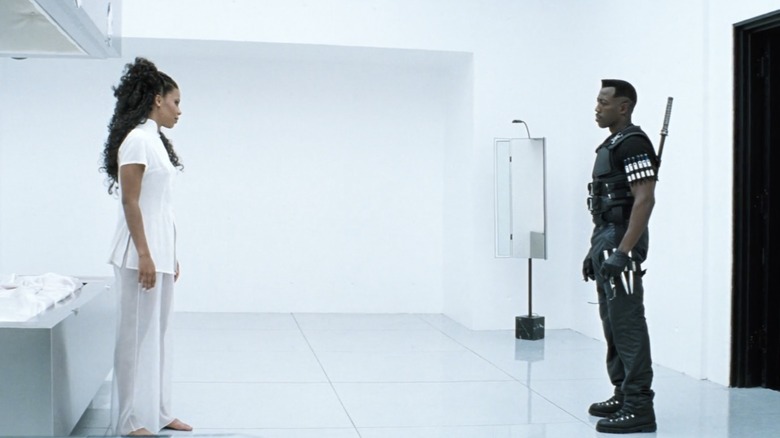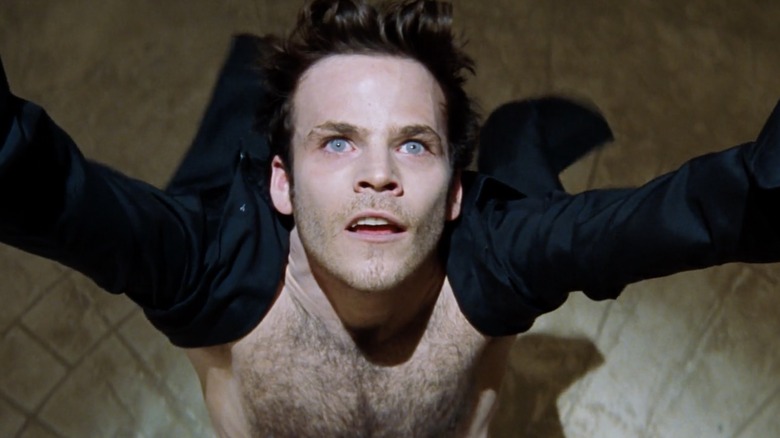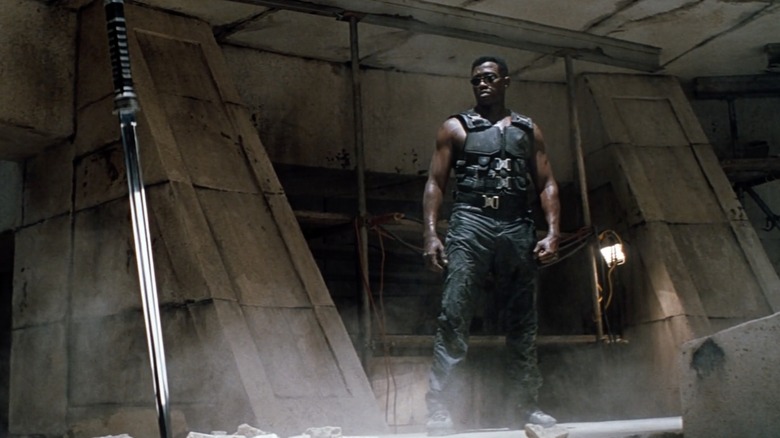The Blade Ending Finally Explained
You might expect a man named Blade would be handing out prizes at a carnival game somewhere in Indiana, but fate had different plans. In the Marvel Universe, Blade is a Daywalker hellbent on dismantling the entire vampire underworld while avoiding any scuffs on his leather ensemble. In the movie trilogy from New Line, the titular character is played by Wesley Snipes, an actor with all the swagger needed to play a brooding demi-vamp.
The first installment in the "Blade" trilogy continues to entertain more than two decades later. Many other vampire-hunting endeavors have attempted to emulate the 1998 film's sleek goth packaging to no avail. With news of Marvel Studios bringing their own Blade into the fold, the time is ripe to revisit the classic and bask in its crimson-soaked glory. Around the time vampires are exploding like angry sorcerers from "Big Trouble in Little China," you may be pondering the film's finer plot points. After all, the primary villain, Deacon Frost (Stephen Dorff), taps into some cryptic mythos in order to achieve his endgame. We haven't exactly translated all the ancient vampiric scrolls, but we have a good idea what Mr. Frost is up to, and it's quite the mischievous scheme. Let's finally get to the heart of what happened at the end of "Blade."
The Daywalker
Cue the bloodbath! Your chef today derives his name from the very tools he uses to filet the bloodsucking antagonists. Blade prefers to dice his enemies with an acid-etched titanium blade that reduces vampires to fluttering bits of carbon. The anger fueling these righteous killing sprees is well deserved — Blade's mother was attacked by a vampire when she was pregnant with him, leading to her death. Fortunately, Blade survived the ordeal and the genetic cocktail introduced while he was still in the womb resulted in his superhuman abilities.
Vampires are known for their aversion to sunlight; while they appear to relish their nocturnal activities, they resent the inability to ever enjoy a sunrise. Their fear and hatred for Blade is cloaked in jealousy because of his ability to walk in the sunlight without bursting into flames. The vampire's physical strength and agility is also his to wield against them. These traits were created under very rare circumstances, making Blade's blood a highly desirable commodity. It's important to know exactly what type of creature Blade is in order to understand why his enemies want to get their hands on him so badly. It isn't just for vengeance — it's also an attempt to improve their cursed existence.
Blood Bath and Beyond
Before "Blade" introduces us to our hero, we get a crash course in vampiric seduction. A man is dragged along by a fanged temptress through the city streets and into a meat packing plant. If you're asking yourself, "What type of meat?" then you are asking the right questions. The unwitting appetizer of a man continues to follow the vampire into her lair despite all signs pointing to danger (because men will be men). Even a corpse on a meat hook cannot deter this man from descending further into an underground nightclub, spurred onward by no more than an aggressive kiss. Once inside the dance club itself, we're introduced to an epileptic's worst nightmare — strobe lights illuminating a sea of scantily clad undead that cheer as the fire sprinkler system rains down human blood.
The scene laid out before us isn't just about sex appeal and the oncoming action sequence that will hook us for the film's entirety. It's also an introduction to the mindset of the primary antagonist, Deacon Frost. There's a quick glimpse of Frost among the lustful dance crew, and a later conversation informs us that the entire club is his establishment. Rather than hiding in the shadows like his vampire brethren, Frost chooses to push further into the human population. This boldness goes against the vampire elders' wishes, and is the driving characteristic behind his whole plan for global domination.
The hematologist working the night shift
The bass slows to a halt and the night club's sprinkler system drips its last few drops of hemoglobin as Blade steps into the room. After a dazzling display of swordsmanship (accented by vampires bursting into clouds of glowing ash), Blade ends his killing spree by nailing Frost's lieutenant, Quinn (Donal Logue) to the wall. Just before law enforcement arrives, Blade tosses an incendiary device at the wily vamp and sneaks out unnoticed. Officers then enter a scene soaked in human blood with a man on fire stapled to the wall. Their demeanor paints the image of a typical Tuesday out on patrol.
This final act in the opening scene is what leads Blade to his greatest asset in this storyline, Dr. Karen Jensen (N'Bushe Wright). Her knowledge of hematology is extremely valuable in Blade's battle against the vampire apocalypse. Luckily for our hero, Dr. Jensen happens to be in the room when Quinn's charred body is being examined. When Quinn wakes up from his little charcoal nap, he immediately sinks his teeth into all the necks he can find, Dr. Jensen's included. Blade is at the hospital to finish off Quinn and stumbles across the wounded doctor. Rather than leaving her to deal with her wounds herself, Blade decides to take her along with him — mostly because Dr. Jensen reminds him of his mother, shown by a flashback to the brief moment after she gave birth to him, a day we definitely all remember.
The Secret War
Once back at Blade's safe house, Karen is introduced to the vampire hunter's friend, Abraham Whistler (Kris Kristofferson). The two give her a quick info dump about the war between vampires and humans. The gist is that vampires are bad and they kill humans. More pressing is the fact that Dr. Jensen has been bitten and the shot of garlic they pump into her veins isn't guaranteed to stop the process of vampire transformation. There are two possible reactions: the doctor could have paint-peeling body odor for several days, or she could become thirsty for the very liquid she swore to keep inside of people.
While Whistler and Blade are telling Karen that she's basically damned, Frost is facing the music as well. The fiasco with Blade has vampire elders in a tizzy. Centuries of secrecy are being jeopardized by Frost's brazen venture into the business of blood-fueled nightclubs. Frost sees his kind as the rightful rulers of the planet. It is obvious that he also has a chip on his shoulder, no doubt stemming from the elders' disdain for his lack of vampiric purity (given that he wasn't born a vampire). The combination of daddy issues and a superiority complex results in Frost's well-laid plans involving ancient script and long lost prophecies.
Out with the old, in with the new
The elders of the vampire council have been around for a long time. Given how slowly vampires age, we can safely assume it takes many centuries for them to obtain an AARP card. It would stand to reason that newfound technological advances are mystical to elderly folk who hunted during Shakespeare's era, so when it's said that ancient scripture is written in a dead language that can never be translated, they see it as an absolute. But Frost has something most grandpas cannot understand — a computer from 1998. Frost is able to use the software's computing power to sift through all the ancient symbols and uncover the mythical tale of La Magra.
Frost seeks to enact a ritual that would release the "blood god" named La Magra. The mythical creature's release would give the power needed for vampires to rise up and take their place as rulers of our planet. The ritual calls for twelve pureblood vampires, and Frost knows just where to gather some up: the elder council. The top dawg, Dragonetti (Udo Kier), would never allow for such a coup, so Frost drags him out to the beach and forces the elder vampire to view a sunrise. Frost and his gang sit safely cocooned in motorcycle helmets and leather to watch Dragonetti get shredded by ultraviolet. Now there's only one major ingredient they need to unleash La Magra: Blade himself.
Blade unravels Frost's schemes
Back at Blade's safe house, Dr. Jensen is refusing to accept her fate as a newborn vampire. She hasn't undergone the transition yet, but Whistler and Blade insist that she will change eventually, and had best prepare accordingly. In order to help her face this newfound affliction, they hand her a gun and send her on her merry way. When Karen arrives home she's met with a familiar (humans who serve vampires), which is exactly what Blade hoped. Much to the doctor's chagrin, Blade used her as bait to uncover another lead.
Dr. Jensen is pretty peeved about the betrayal, but she can't deny it works. Not only is she certain she needs to stick with the vampire hunter in order to stay alive, but the shifty maneuver is also what leads Blade to the vampire archives, where the Book of Erebus is housed. The "vampire bible" consists of the ancient texts we saw Frost deciphering earlier. An assertive chat with a blob of vampire meat gives Blade all the information he needs. He now knows that his own blood is vital in bringing Frost's plan to fruition. The logical move would be to avoid capture via any obvious traps. There's a big problem there, though: vampires are just so good at ticking Blade off.
Means to an end
Slowly morphing into one of the undead is a fate Karen is unwilling to accept. Induction into a new world of blood is unacceptable, and she means to use her own knowledge of blood to halt the transformation. The working conditions in the vampire hunting crew's warehouse aren't exactly ideal for the enactment of the scientific method, though. The doctor returns to her workplace and marches out with an entire laboratory of equipment that would make burly movers in New York struggle. Good thing, too, because her tenacity gives Blade some new tools that could make victory possible.
In order to satiate his own thirst, Blade uses a serum in place of actual human blood. This method is becoming less effective as time goes on, but now the soldier of misfortune has a hematologist on his side. Karen gets to work on synthesizing a cure for herself and a new serum for Blade. The scientific journey gives rise to some wild failures disguised as newfound weaponry for Blade. While experimenting with an anticoagulant on vampire blood, they discover that it explodes on contact. It's a potent reaction that definitely calls for weaponization. The crew loads the anticoagulant into vials and inserts them into what can only be described as ... combat syringes? Whatever you call them, the accidental discovery of this new weapon is the only reason the world doesn't fall prey to an all-powerful race of hungry vampires.
Crafty little bloodsuckers
Blade is known as the Daywalker, and it stands to reason we get to see him out on a sunlit stroll. The hero is out running errands when he comes upon ... a vampire? Aren't vampires unable to be in the sunlight without having their flesh melt off and bursting into flames? The nuance of vampire mythology is used pretty loosely here, so we can't speak to exactly what extreme level of SPF sunscreen our boy Deacon Frost is using. What we can say is this is a 1998 comic book film about vampire slaying and it looks like a cloudy day in the city anyways.
The hero/villain conversation ends with Frost tossing a girl into the street, where she nearly gets plowed into by a bus driver with either no eyeballs or no brakes. Blade does what heroes do and saves her, but the distraction Frost hoped for has already been put into motion. The vampires have discovered where Whistler and Blade shack up, and while the Daywalker is out buying kimchi (probably) they raid the place. It's another carefully-laid piece of Frost's plan. In order to unleash La Magra, they need Blade's blood, and he certainly won't give it willingly. Poking the bear is never recommended, but in this case, hey, it works.
O Mother, where art thou?
Frost puts his best fang forward in his attempts to infuriate our hero. It's actually not so much an attempt as it is a wild success. The vampires leave a mangled Whistler behind to slowly die. Blade is able to say goodbye (in his own way), but he's so angry that he knowingly marches into a trap laid by Frost. The vampire hunter is able to put his new weapons on display (the anti-coagulant) by plunging the syringes into the chest and skull of some undead security guards. Cool guys don't look at explosions, so he marches further into the vampire den while his defeated foes explode into a gooey fountain of blood behind him.
There are few things that could distract Blade from his current mission of vengeance. Actually, we can confidently say there is only one thing and Frost has exactly that one thing: Blade's mommy. Yep! The woman is alive and well, chilling in a penthouse and sipping on hemoglobin martinis. The brief, tender reunion distracts our unwitting hero long enough for Frost and his gang to temporarily put him out of commission. Subsequently depriving Blade of his serum weakens Blade and causes "the thirst" to envelop him.
The ritual of La Magra
Blood gods always come with specific instructions. You'd think a near-invincible celestial would do something to ensure their rebirth be reasonably attainable — for example, binding themselves to a Tamagotchi that triggers their release should you keep it alive for more than a month. La Magra likes to be dramatic, though. The ritual to release La Magra involves an ancient temple built for this sole purpose. Frost took control of the vampire council not just because he resented Dragonetti, but also because this blood god ritual requires twelve purebloods. Each of these natural-born vampires must be positioned in the temple among a series of glyphs.
At the top of the temple is a chamber made specifically to house our boy Blade. Well, any type of "Daywalker" really, but Blade is the only one known to exist as of this moment. The chamber drains his blood and spreads it out amongst the purebloods positioned on the glyphs. The winged specters that emerge from each council member are a visual representation of the vampiric soul, each one seeking out its new godly master. The final blood globule drips down from the center directly onto the recipient of the might of La Magra — in this case, Deacon Frost.
The savior of mankind, and Karen
Deacon Frost now houses the might of La Magra and Blade is weak, drained of his most necessary bodily fluid. The Daywalker is infinitely lucky he ran into Dr. Karen Jensen. The unsung hero of "Blade" manages to cure herself of her vampiric affliction, then escapes the clutches of a vampire zombie and scales the temple of La Magra to release Blade from his stone prison. If that isn't enough, she revitalizes the half-breed by allowing him to suck blood from her neck.
A rejuvenated Blade leaps from the top floor of the temple into a picture perfect superhero landing. Quinn is unceremoniously released from his undead form, allowing Blade to reclaim his sunglasses — a necessary tool for the battle about to unfold. Some slicing and dicing displays the fact that Blade may be royally screwed. Deacon Frost's regenerative abilities are extensive, going so far as to instantly reattach severed limbs. Combined with super-speed and strength, it appears the newborn blood god is undefeatable. That's when Karen comes to the rescue (words not often said without sarcasm). The vials of anticoagulant she created for Blade are the only way he is able to defeat the powerful Deacon "La Magra" Frost. Several doses of the weaponized medicine cause the villain's blood to reach a boiling point and reduce him to a pile of vampire goop, from which regeneration is improbable.
In short, the main lessons we learn from "Blade" are that science is mightier than the sword, and that you shouldn't trust a mean girl who leads you into a meat locker.
